Article contents
The Eckert–Weise effect and energy separation under the flow interference behind side-by-side cylinders
Published online by Cambridge University Press: 25 March 2021
Abstract

The total enthalpy of a uniform flow is redistributed behind a thermally insulated body such that a considerable cooling of fluid in terms of total temperature occurs near the wake centreline. This energy separation phenomenon is also observed after time averaging and can lead to the recovery temperature at the rear part of the body becoming lower than the static temperature of the incoming flow (the Eckert–Weise effect). By the numerical solution of the Navier–Stokes equations, the present work studies energy separation in the wake, the Eckert–Weise effect and their sensitivity on the flow interference behind side-by-side cylinders. The considered distances between the cylinders cover the key regimes of interference: single, bistable and coupled vortex streets. The first and second regimes amplify the efficiency of energy separation in the wake and the intensity of the Eckert–Weise effect, respectively. In the developed wake, a clear relation between the vortex structure and the total enthalpy redistribution is demonstrated as well as a limitation on the intensity of this redistribution imposed by the deficit of velocity. The connection of the Eckert–Weise effect with the vortex formation process is clarified. Among the mechanisms changing the total enthalpy in fluid particles, the non-stationarity of pressure defines the averaged distribution: the decrease of pressure in forming vortices is mainly responsible for the cooling of fluid behind the body. The balance with the heating of the rear surface by the involvement of fluid from the sides defines the intensity of the effect.
JFM classification
- Type
- JFM Papers
- Information
- Copyright
- © The Author(s), 2021. Published by Cambridge University Press
References
REFERENCES
- 10
- Cited by





